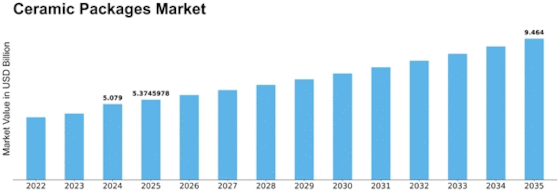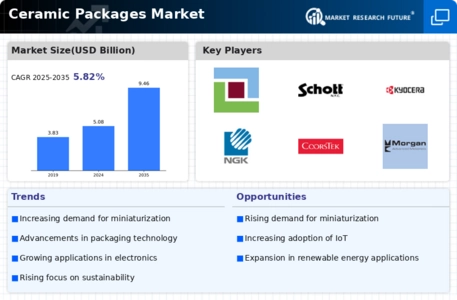Ceramic Package Size
Ceramic Package Market Growth Projections and Opportunities
The Ceramic Packages market is shaped by various factors that collectively influence its dynamics within the electronics and semiconductor industry. One of the primary drivers behind the growth of the Ceramic Packages market is the increasing demand for high-performance electronic devices. Ceramic packages, known for their excellent thermal conductivity, mechanical strength, and electrical insulation properties, are essential components for protecting and enhancing the performance of semiconductor devices. As the demand for smaller, faster, and more reliable electronic devices continues to rise, the market for ceramic packages experiences growth, especially in applications like integrated circuits and power modules.
Ceramic Packages Market Size was valued at USD 4.2 Billion in 2022. The Ceramic Packages industry is projected to grow from USD 4.8 Billion in 2023 to USD 8.1 billion by 2032, exhibiting a compound annual growth rate (CAGR) of 5.80% during the forecast period (2023 - 2032).
Economic factors play a crucial role in determining the demand for Ceramic Packages. Economic growth, industrial expansion, and the proliferation of electronics in various sectors contribute to the demand for semiconductor devices, consequently driving the market for ceramic packages. Industries such as automotive, telecommunications, and consumer electronics, major consumers of semiconductor devices, are instrumental in shaping the demand for ceramic packaging solutions. Conversely, economic downturns may lead to reduced consumer spending and impact the overall demand for electronic devices and ceramic packages.
Raw material prices and availability are critical factors influencing the Ceramic Packages market. The primary materials used in manufacturing ceramic packages, including alumina and other ceramics, are subject to market fluctuations. Changes in raw material prices, geopolitical events affecting the supply chain, and advancements in material technologies can impact the production cost of ceramic packages, influencing market dynamics. Manufacturers in the ceramic packages sector must closely monitor these factors to maintain a stable supply chain and competitive pricing.
Technological advancements contribute to the evolution of the Ceramic Packages market. Ongoing research and development efforts focus on improving the thermal management capabilities of ceramic packages, optimizing manufacturing processes, and exploring new materials for enhanced performance. Innovations in ceramic packaging technologies, such as the development of advanced multilayer structures, contribute to the miniaturization and improved reliability of electronic devices, driving the market forward.
Environmental regulations and sustainability considerations are increasingly shaping the Ceramic Packages market. As awareness of environmental issues grows, industries are under pressure to adopt cleaner and more sustainable practices. Manufacturers are exploring environmentally friendly alternatives and sustainable manufacturing processes for ceramic packages to align with regulatory standards and meet the preferences of environmentally conscious consumers. Recycling initiatives for electronic waste, including ceramic packages, are gaining importance in the industry.
Global market trends and trade dynamics also impact the Ceramic Packages market. The interconnectedness of economies means that changes in one region can have cascading effects on the supply and demand for ceramic packages worldwide. Trade agreements, tariffs, and geopolitical events can influence the international trade of electronic components, including ceramic packages, affecting market conditions for manufacturers and distributors. Companies in the ceramic packages market need to stay informed about global dynamics to navigate potential challenges and capitalize on opportunities.
Consumer preferences and industry standards contribute to the market factors shaping the Ceramic Packages industry. The demand for smaller, more powerful electronic devices with enhanced reliability aligns with changing consumer expectations. Manufacturers are adapting their ceramic packaging solutions to meet industry standards and consumer preferences, including the development of packages suitable for advanced applications like 5G technology and artificial intelligence.










Leave a Comment